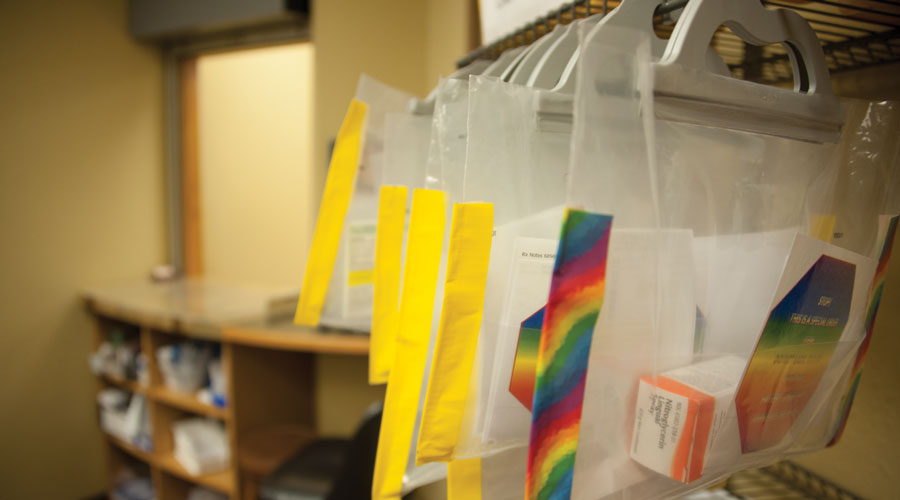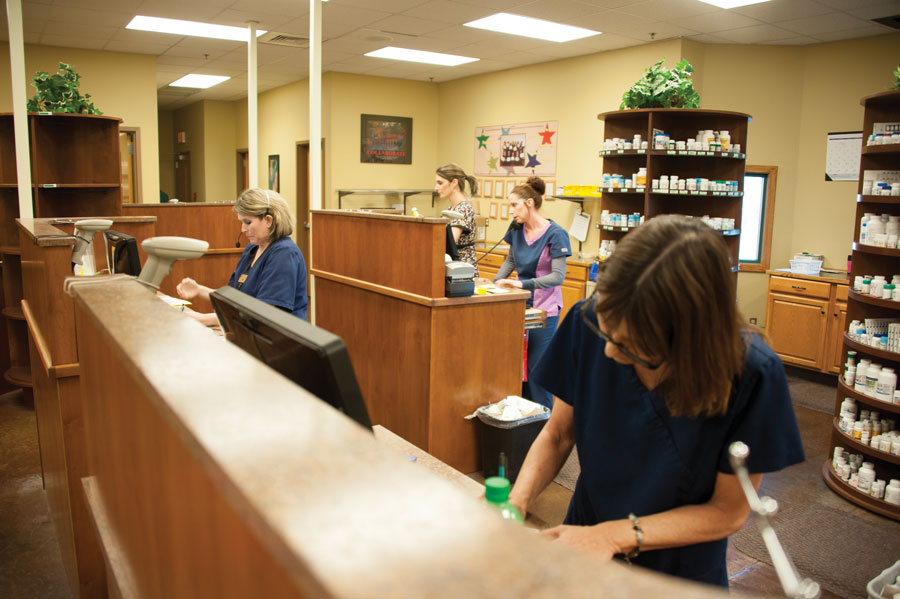For 10 years, Don Grove, R.Ph., owner of J&D Pharmacy in Warsaw, Mo., has worked to improve the traditional pharmacy workflow. After three stages of major changes, he has now finalized a patented workflow system for his pharmacy that he says improves accuracy, speed and employee satisfaction.
“Employees are doing more volume in the same amount of time, but the efficient workflow system has made it more relaxed and easier to handle the workload,” Grove said.
Just exactly how much has the new workflow system increased productivity?
“We have tripled our verification and filling speed for both pharmacists and technicians,” Grove said. “In my little town of 2,000 people in Warsaw, Mo., I have verified 1,000 prescriptions in a day by myself, which I call the perfect storm,” he said.
“Today our pharmacists feel comfortable with 350 to 500 each. The NCPA Digest average is about 128 per pharmacist,” he said. “We have peaks of 700. The pharmacists don’t feel comfortable with 700, but they can do it. Our technician record is 176 compared to the NCPA Digest average of 55.”
Better for everyone
To reach those record numbers, Grove rethought the traditional prescription filling process. Instead of the typical single counter found in pharmacies where everybody works in the same space, Grove separated each function into its own area. These include drop off areas, an order entering station, individual pharmacist and technician filling stations, verification stations, a bagging station and counseling areas.
Grove has found that breaking down the process into distinct areas has helped with productivity. It has enabled him to be a more effective manager by placing his employees in the positions where they can do their best work, he said.
“There are production pharmacists and production techs, and clinical pharmacists and clinical techs,” he said. “Clinicals like counseling and resolving problems and productioners like to kick out the Rxs. We let
each do what they love doing. When you get the right person in the right position, it maximizes volume, accuracy and employee satisfaction.”
Embracing a more efficient workflow system can also lead to better patient care, Grove said.
“What do you do when three people walk in and one’s waiting on a prescription, one wants a flu vaccine and the other wants a shingles shot?” Grove said. “Do you think they want to sit around for an hour until you get caught up? No, they’re going to head off to the local health organization or to another pharmacy.”
“When you have a workflow that is so efficient that one pharmacist can do 300, 400, 500 in a day, then it’s no problem for the other pharmacist to disappear and go do those shots and take 10 minutes or 30 minutes,” he said. “Improving productivity is huge because it gives you an opportunity to counsel and spend more time on those niches, like MTM, vaccinations and compounding.”
Improving the workspace
Besides increasing productivity, the new workflow system has also created a more pleasant work environment in the pharmacy, Grove said.
The workflow system includes inventory carousels, prescription bags that hang (instead of bins) and separate pharmacy and technician workstations that all increase storage while saving on floor space.
“In the typical pharmacy, everyone is standing elbow to elbow,” Grove said. “Mine is very open. My people are able to enjoy themselves and walk around. They’re not all crammed in.”
The floor plan may be open, but Grove specifically designed the backend of the pharmacy to be more divided from the front. The prescription drop off and counseling windows are the only areas open to patients. “If the environment is too open, you’re going to see more and more disruptions and errors as volume increases,” he said.
A continuous process
Grove has found a workflow system that works well for his business, but he’s always on the lookout for ways to improve it. Right now he’s figuring out how to print prescription labels that will direct technicians to the inventory carousel where the drug they need is located. He also wants to install lights that light up the quadrant where the drug is positioned, to limit search time.
“I’m always excited about doing one better,” he said.
Profile of J&D Pharmacy’s Workflow System
Like a puzzle, the different pieces of the workflow system at J&D Pharmacy fit together seamlessly. Here’s a look at the parts and how they differ from typical pharmacy workflow.
Order entry point
The pharmacy features one central point where all prescriptions are entered into the system and prioritized. “We picked one person who had really good entering skills and could multitask talking to the patients and now she does all the entering,” Grove said.
Technician workstation
Each technician is assigned an individual filling station complete with a printer (for printing labels), touch screen computer and a phone with headset. Storage areas for belongings, designated cup holders and monitors to display family photos free up counter space. Each station also features a bar for hanging prescription bags, so they’re off the counter.
Color-coded prescription bags
The pharmacy uses clear bags to place all prescriptions in during the filling and checking process. The bags are color coded by urgency. Red means the customer is waiting. Yellow means the customer is coming in sometime that day to pick it up. Green means the customer is coming in the next day or in the near future. Rainbow is for a special order or for drugs that are expensive.
“The bags are color coded so the pharmacist only works on prescriptions that are waiting and then in order of urgency, which lowers stress levels,” Grove said. Pouches on the front and back of each bag allow for easy storage of pricing and auxiliary labels, such as “Refrigerate.”
Pharmacist check station
Similar to the inventory carousel, the pharmacist check station is cylindrical in shape and swivels. The check station carousel is divided into four time slots: 7 a.m. – 9 a.m., 9 a.m. – 12 p.m., 12 p.m. – 3 p.m. and 3 p.m. – 6 p.m. The check station features bars where technicians hang green, yellow or rainbow prescription bags according to the timeframe when they place them in the slot. Red bags go immediately to the pharmacist’s workstation.
Pharmacist workstation
Each pharmacist has an individual workstation for the traditional checking of information. The pharmacist workstation closely resembles the technician workstation with a touch screen computer, phone, storage areas and a monitor to display family photos. The pharmacist workstation sits in close proximity to the narcotics cabinet and includes a pull-out tray that holds counting supplies and prescription pads.
OTC bagging station
A separate area of the pharmacy is dedicated to getting prescriptions ready at point of sale. It features a horizontal bar where the color-coded prescription bags hang to free up counter space.
A Member-Owned Company Serving Independent Pharmacies
PBA Health is dedicated to helping independent pharmacies reach their full potential on the buy-side of their business. Founded and owned by pharmacists, PBA Health serves independent pharmacies with group purchasing services, wholesaler contract negotiations, proprietary purchasing tools, and more.
An HDA member, PBA Health operates its own NABP-accredited secondary wholesaler with more than 6,000 SKUs, including brands, generics, narcotics CII-CV, cold-storage products, and over-the-counter (OTC) products — offering the lowest prices in the secondary market.














